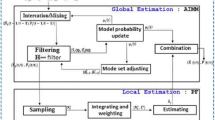Abstract
Inspired by the way humans perceive the environment, in this paper, we propose a memory-based cognitive model for visual information processing which can imitate some cognitive functions of the human brain such as remembering, recall, forgetting, learning, classification, and recognition, etc. The proposed model includes five components: information granule, memory spaces, cognitive behaviors, rules for manipulating information among memory spaces, and decision-making processes. Three memory spaces are defined for separately storing the current, temporal and permanent information acquired, i.e. ultra short-term memory space (USTMS), short-term memory space (STMS) and long-term memory space (LTMS). The proposed memory-based model can remember or forget what the scene has ever been which helps the model adapt to the variation of the scene more quickly. We apply the model to address two hot issues in computer vision: background modeling and object tracking. A memory-based Gaussian mixture model (MGMM) for object segmentation and a memory-based template updating (MTU) model for object tracking with particle filter (PF) are exhibited respectively. Experimental results show that the proposed model can deal with scenes with sudden background and foreground changes more robustly when segmenting and tracking moving objects under complex background.


















Similar content being viewed by others
References
Lin JH (1994) A theory for memory-based learning. Mach Learn 17:143–167
Wang Y, Chiew V (2010) On the cognitive process of human problem solving. Cognitive Systems Research 11(1):81–92
Putze F, Schultz T (2009) Cognitive memory modeling for interactive systems in dynamic environments. In: 1st international workshop on spoken dialog systems (IWSDS2009), Kloster Irsee, Germany
Dinerstein J, Egbert PK, Garis H, Dinerstein N (2004) Fast and learnable behavioral and cognitive modeling for virtual character animation. Comput Animat Virtual Worlds 15:95–108
Yang Z, Fan Y, Zhang B, Cheng X (2010) A computation memory model with human memory features for autonomous virtual humans. In: Proceedings of international conference on computer application and system modeling (ICCASM 2010), vol 3, pp 246–250
Ai DM, Ban XJ, Zhang SJ (2007) Cognitive modeling of artificial fish learning and memory. In: Proceedings of the 12th international symposium on artificial life and robotics (AROB 12th’07), pp 280–283
Ho WC, Dautenhahn K, Lim MY, Casse KD (2010) Modeling human memory in robotic companions for personalization and long-term adaptation in HRI. In: Proceedings of the first annual meeting of the biologically inspired cognitive architecture (BICA) society, Washington, DC, USA, pp 64–71
Gnjatović M, Janev M, Delić V (2012) Focus tree: modeling attentional information in task-oriented human-machine interaction. Appl Intell 37(3):305–320
Huang S, Sadek Adel W (2009) A novel forecasting approach inspired by human memory: the example of short-term traffic volume forecasting. Transp Res, Part C, Emerg Technol 17:510–525
James W (1890) Principles of psychology. Holt, New York
Atkinson RC, Shiffrin MR (1968) Human memory: a proposed system and its control processes. In: Spence KW (ed) The psychology of learning and motivation, vol 2. Academic Press, New York, pp 89–195
Baddeley AD, Hitch GJ (1974) Working memory. In: Bower GH (ed) The psychology of learning and motivation, vol 8, pp 47–89
Wang Y, Wang Y (2006) Cognitive informatics models of the brain. IEEE Trans Syst Man Cybern, Part C, Appl Rev 36(2):203–207
Wang Y (2009) Formal description of the cognitive process of memorization. In: Transactions of computational science V, pp 81–98
Eysenck MW, Keane MT (2010) Cognitive psychology: a student’s handbook, 6th edn. Psychology Press, New York
Morgan H (2004) Real learning: a bridge to cognitive neuroscience. R&L Education
Skowron A, Stepaniuk J (2001) Information granules: towards foundations of granular computing. Int J Intell Syst 16(1):57–85
Julius HM, Ali Akber DM, Chae O (2012) A flexible edge matching technique for object detection in dynamic environment. Appl Intell 36(3):638–648
Mirghasemi S, Yazdi HS, Lotfizad M (2012) A target-based color space for sea target detection. Appl Intell 36(4):960–978
Piccardi M (2004) Background subtraction techniques: a review. In: Proceedings of IEEE international conference on systems, man and cybernetics, Hague, Netherlands, pp 3099–3104
Stauffer C, Grimson W (1999) Adaptive background mixture models for real-time tracking. In: Proceedings of IEEE conference on computer vision and pattern recognition, Ft Collins, CO, USA, pp 246–252
Stauffer C, Grimson W (2000) Learning patterns of activity using real-time tracking. IEEE Trans Pattern Anal Mach Intell 22(8):747–757
Popović B, Janev M, Pekar D, Jakovljević N, Gnjatović M, Sečujski M, Delić V (2012) A novel split-and-merge algorithm for hierarchical clustering of Gaussian mixture models. Appl Intell 37(3):377–389
Lee DS (2002) Improved adaptive mixture learning for robust video background modeling. In: Proceedings of IAPR workshop on machine vision applications, Nara-ken New Public Hall, Nara, Japan, pp 443–446
Lee DS (2005) Effective Gaussian mixture learning for video background subtraction. IEEE Trans Pattern Anal Mach Intell 27(5):827–832
Yilmaz A, Javed O (2006) Object tracking: a survey. ACM Comput Surv 38(4):1–45
Gordon NJ, Salmond DJ, Smith AFM (1993) Novel approach to nonlinear/non-Gaussian Bayesian state estimation. IEE Proc F, Radar Signal Process 140(2):107–113
Arulampalam MS, Maskell S, Gordon N, Clapp T (2002) A tutorial on particle filters for online nonlinear/non-Gaussian Bayesian tracking. IEEE Trans Signal Process 50(2):174–188
Zhou SK, Chellappa R, Moghaddam B (2004) Visual tracking and recognition using appearance-adaptive models in particle filters. IEEE Trans Image Process 13(11):1491–1506
Li AP, Jing ZL, Hu SQ (2007) Robust observation model for visual tracking in particle filter. AEÜ, Int J Electron Commun 61(3):186–194
Comaniciu D, Ramesh V, Meer P (2003) Kernel-based object tracking. IEEE Trans Pattern Anal Mach Intell 25(5):564–577
BMP image sequences for elliptical head tracking. http://www.ces.clemson.edu/~stb/research/headtracker/seq
Shadow detection. http://cvrr.ucsd.edu/aton/shadow/
Acknowledgements
The paper is funded by the National Natural Science Foundation of P.R. China (No. 60873163, No. 61271407), and the Fundamental Research Funds for the Central Universities (No. 27R1105019A).
Author information
Authors and Affiliations
Corresponding author
Rights and permissions
About this article
Cite this article
Wang, Y., Qi, Y. Memory-based cognitive modeling for robust object extraction and tracking. Appl Intell 39, 614–629 (2013). https://doi.org/10.1007/s10489-013-0437-5
Published:
Issue Date:
DOI: https://doi.org/10.1007/s10489-013-0437-5




